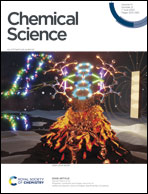Confinement of an alkaline environment for electrocatalytic CO2 reduction in acidic electrolytes†
Abstract
Acidic electrochemical CO2 reduction reaction (CO2RR) can minimize carbonate formation and eliminate CO2 crossover, thereby improving long-term stability and enhancing single-pass carbon efficiency (SPCE). However, the kinetically favored hydrogen evolution reaction (HER) is generally predominant under acidic conditions. This paper describes the confinement of a local alkaline environment for efficient CO2RR in a strongly acidic electrolyte through the manipulation of mass transfer processes in well-designed hollow-structured Ag@C electrocatalysts. A high faradaic efficiency of over 95% at a current density of 300 mA cm−2 and an SPCE of 46.2% at a CO2 flow rate of 2 standard cubic centimeters per minute are achieved in the acidic electrolyte, with enhanced stability compared to that under alkaline conditions. Computational modeling results reveal that the unique structure of Ag@C could regulate the diffusion process of OH− and H+, confining a high-pH local reaction environment for the promoted activity. This work presents a promising route to engineer the microenvironment through the regulation of mass transport that permits the CO2RR in acidic electrolytes with high performance.

- This article is part of the themed collections: Most popular 2023 energy & environmental chemistry articles, In celebration of the Lunar New Year, 2024 and 2023 Chemical Science HOT Article Collection


 Please wait while we load your content...
Please wait while we load your content...